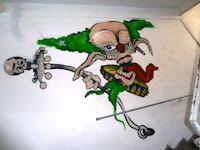Fasching is German Carnival (Karneval in some parts): the children (mostly) dress up and attend parties. It struck me as the original teutonic equivalent of Halloween, an increasingly popular American import here. My Bible Study decided not to celebrate Fasching; I had Eierkuchen (like a crepe) for dinner. I didn’t hear anything about Ash Wednesday (Ashermittwoch) services, which is unfortunate, as it's one of my favorite observances of the year. It's not very common, at least in circles I inhabit, but I learned on radio that fasting of various kinds is practiced: maybe a total fast on Ash Wednesday and Good Friday; or else a modified fast for a week; and sometimes just for certain things (like chocolate, or television). I also discovered that green is associated here at least as much with "envy" as with "hope"--what we call Maundy Thursday is "Grünfreitag" here. And on Karfreitag (Good Friday), I almost attended a service at our “mother church,” Oase, ... but I read the map wrong and got lost, despite asking for directions. It probably would have been a contemporary service of praise songs and prayer, much like our Sunday worship services.
Nothing much in particular distinguished Palm Sunday or Easter Sunday from any other day, except for the gist of the sermons. Easter was bittersweet for me, as it was also my last Sunday with the church I have been attending for the last 7 months. I don't know that we got to know each other particularly well, but they were familiar, friendly faces, and we were happy to see each other every week. I'm very glad to have been a part of Gott@Prohlis and hope that this little church plant continues to grow in that often neglected suburb. (The website is in German and under construction; eventually there may even be pictures of me.)
For most Germans, Easter is about the candy and chocolate rabbits that began appearing in the grocery stores a few weeks before Ash Wednesday. Even if they aren't religious, many people still dye Easter eggs, especially using the wax batik technique common in Central/Eastern Europe. (In the photo you can see the green egg ornament a member of my Bible Study gifted to me.) Probably my favorite custom is the decoration of bushes and trees with colored eggs. I've seen this in the US, but it was more common here and made the city colorful and festive. The most obvious manifestation of the Easter holiday(s) is that Good Friday and Easter Monday are both public holidays, so everything closes except the museums and the lone 365-day-a-year grocery store in town, at the Neustadt Bahnhof. Spring Break for the schools is happening this week, too, so many people use the time to travel, visit friends, etc. Soon I'll put up another post about my Holy Saturday visit to a famous Saxon castle, Schloss Moritzburg. For now I will wish you, Frohe Ostern!
Invocavit (Invocation) – "Call upon me, and I will answer you." (Psalm 91:15)
Reminiscere (Remembrance) – "Remember, O LORD, your great mercy and love!" (Psalm 25:6)
Oculi (Seeing) – "My eyes are ever on the Lord." (Psalm 25:15)
Laetare (Joy) – "Rejoice with Jerusalem!" (Isaiah 66:10)
Judica (Justice) – "Vindicate me, O God." (Psalm 43:1)
Palmarum (Palm Sunday) – Jesus triumphant entry into Jerusalem (John 12:12–19)
In German you can remember the Sundays with the mnemonic: „In rechter Ordnung lerne Jesu Passion,“ which translates as “Learn Jesus’ passion [story] in the right order."
Wikipedia tells me that Invocation Sunday is associated in Protestant tradition with Martin Luther’s eight famous “Invocation Sermons” given in Wittenberg in 1522, which immediately became classic formulations of his radical (but not too radical) new theology. Also, apparently current Catholic practice associates Psalm 27: 8 with Remembrance Sunday, “My heart says, search for God's face!,” which is also a good verse.
* * * * *
*--Presumably you've heard of "store-front" churches. Well, there's a bank in the front of our building, and we have two rooms in the rear. Ergo, "store-back" church.
























